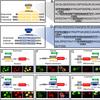Image analysis
2018
Dec
08
Nucleolar image-based screen dataset viewable online with OMERO
New automated imaging at the DRSC
. 2012. “Differential RNAi screening provides insights into the rewiring of signalling networks during oxidative stress.” Mol Biosyst, 8, 10, Pp. 2605-13.Abstract
. 2008. “RNA interference screening in Drosophila primary cells for genes involved in muscle assembly and maintenance.” Development, 135, 8, Pp. 1439-49.Abstract
. 2013. “A screen for morphological complexity identifies regulators of switch-like transitions between discrete cell shapes.” Nat Cell Biol, 15, 7, Pp. 860-71.Abstract
. 2008. “COPI complex is a regulator of lipid homeostasis.” PLoS Biol, 6, 11, Pp. e292.Abstract
. 2014. “Identification of regulators of the three-dimensional polycomb organization by a microscopy-based genome-wide RNAi screen.” Mol Cell, 54, 3, Pp. 485-99.Abstract
. 2010. “Automatic robust neurite detection and morphological analysis of neuronal cell cultures in high-content screening.” Neuroinformatics, 8, 2, Pp. 83-100.Abstract
. 2006. “High-throughput RNAi screening in cultured cells: a user's guide.” Nat Rev Genet, 7, 5, Pp. 373-84.Abstract
. 2012. “Identification of genes that promote or antagonize somatic homolog pairing using a high-throughput FISH-based screen.” PLoS Genet, 8, 5, Pp. e1002667.Abstract



